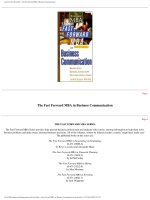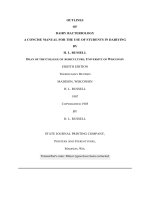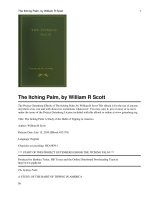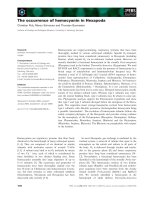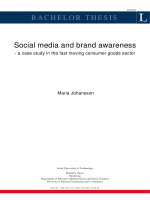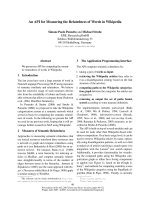The Fast Forward MBA in Finance_15 doc
Bạn đang xem bản rút gọn của tài liệu. Xem và tải ngay bản đầy đủ của tài liệu tại đây (186.79 KB, 15 trang )
example, mutual funds revalue their securities portfolios every day based
on closing prices on the New York Stock Exchange and Nasdaq. Gener-
ally speaking, however, businesses do not use the mark-to-market method
to write up the value of their assets. A business, for instance, does not
revalue its fixed assets (buildings, machines, equipment, etc.) at the end
of each period—even though the replacement values of these assets fluc-
tuate over time. Having made this general comment, I should mention
that accounts receivable are written down to recognize bad debts, and a
business’s inventories asset account is written down to recognize stolen
and damaged goods as well as products that will be sold below cost. If
certain of a business’s long-term operating assets become impaired and
will not have productive utility in the future consistent with their book
values, then the assets are written off or written down, which can result
in recording a large extraordinary loss in the period.
market capitalization, or market cap Current market value per share of
capital stock multiplied by the total number of capital stock shares out-
standing of a publicly owned business. This value often differs widely from
the book value of owners’ equity reported in a business’s balance sheet.
negative cash flow The cash flow from the operating activities of a busi-
ness can be negative, which means that its cash balance decreased from
its sales and expense activities during the period. When a business is
operating at a loss instead of making a profit, its cash outflows for
expenses very likely may be more than its cash inflow from sales. Even
when a business makes a profit for the period, its cash inflow from sales
could be considerably less than the sales revenue recorded for the
period, thus causing a negative cash flow for the period. Caution: This
term also is used for certain types of investments in which the net cash
flow from all sources and uses is negative. For example, investors in
rental real estate properties often use the term to mean that the cash
inflow from rental income is less than all cash outflows during the
period, including payments on the mortgage loan on the property.
net income (also called the bottom line, earnings, net earnings, and net
operating earnings) This key figure equals sales revenue for a period
less all expenses for the period; also, any extraordinary gains and losses
for the period are included in this final profit figure. Everything is taken
into account to arrive at net income, which is popularly called the bottom
line. Net income is clearly the single most important number in business
financial reports.
net present value (NPV) Equals the present value (PV) of a capital invest-
ment minus the initial amount of capital that is invested, or the entry cost
APPENDIX A
306
of the investment. A positive NPV signals an attractive capital investment
opportunity; a negative NPV means that the investment is substandard.
net worth Generally refers to the book value of owners’ equity as reported
in a business’s balance sheet. If liabilities are subtracted from assets, the
accounting equation becomes: assets − liabilities = owners’ equity. In this
version of the accounting equation, owners’ equity equals net worth, or
the amount of assets after deducting the liabilities of the business.
operating activities Includes all the sales and expense activities of a busi-
ness. But the term is very broad and inclusive; it is used to embrace all
types of activities engaged in by profit-motivated entities toward the
objective of earning profit. A bank, for instance, earns net income not
from sales revenue but from loaning money on which it receives interest
income. Making loans is the main revenue operating activity of banks.
operating cash flow See cash flow from operating activities.
operating leverage A relatively small percent increase or decrease in
sales volume that causes a much larger percent increase or decrease in
profit because fixed expenses do not change with small changes in sales
volume. Sales volume changes have a lever effect on profit. This effect
should be called sales volume leverage, but in practice it is called oper-
ating leverage.
operating liabilities The short-term liabilities generated by the operating
(profit-making) activities of a business. Most businesses have three types
of operating liabilities: accounts payable from inventory purchases and
from incurring expenses, accrued expenses payable for unpaid expenses,
and income tax payable. These short-term liabilities of a business are
non-interest-bearing, although if not paid on time a business may be
assessed a late-payment penalty that is in the nature of an interest
charge.
operating profit See earnings before interest and income tax (EBIT).
overhead costs Overhead generally refers to indirect, in contrast to direct,
costs. Indirect means that a cost cannot be matched or coupled in any
obvious or objective manner with particular products, specific revenue
sources, or a particular organizational unit. Manufacturing overhead
costs are the indirect costs in making products, which are in addition to
the direct costs of raw materials and labor. Manufacturing overhead
costs include both variable costs (electricity, gas, water, etc.), which vary
with total production output, and fixed costs, which do not vary with
increases or decreases in actual production output.
307
APPENDIX A
owners’ equity Refers to the capital invested in a business by its share-
owners plus the profit earned by the business that has not been distrib-
uted to its shareowners, which is called retained earnings. Owners’
equity is one of the two basic sources of capital for a business, the other
being borrowed money, or debt. The book value, or value reported in a
balance sheet for owners’ equity, is not the market value of the business.
Rather, the balance sheet value reflects the historical amounts of capital
invested in the business by the owners over the years plus the accumula-
tion of yearly profits that were not paid out to owners.
present value (PV) This amount is calculated by discounting the future
cash returns from a capital investment. The discount rate usually is the
cost-of-capital rate for the business. If PV is more than the initial amount
of capital that has to be invested, the investment is attractive. If less,
then better investment alternatives should be found.
price/earnings (P/E) ratio This key ratio equals the current market price
of a capital stock share divided by the earnings per share (EPS) for the
stock. The EPS used in this ratio may be the basic EPS for the stock or its
diluted EPS—you have to check to be sure about this. A low P/E may sig-
nal an undervalued stock or may reflect a pessimistic forecast by
investors for the future earnings prospects of the business. A high P/E
may reveal an overvalued stock or reflect an optimistic forecast by
investors. The average P/E ratio for the stock market as a whole varies
considerably over time—from a low of about 8 to a high of about 30.
This is quite a range of variation, to say the least.
product cost This is a key factor in the profit model of a business. Product
cost is the same as purchase cost for a retailer or wholesaler (distribu-
tor). A manufacturer has to accumulate three different types of produc-
tion costs to determine product cost: direct materials, direct labor, and
manufacturing overhead. The cost of products (goods) sold is deducted
from sales revenue to determine gross margin (also called gross profit),
which is the first profit line reported in an external income statement
and in an internal profit report to managers.
profit The general term profit is not precisely defined; it may refer to net
gains over a period of time, or cash inflows less cash outflows for an
investment, or earnings before or after certain costs and expenses are
deducted from income or revenue. In the world of business, profit is
measured by the application of generally accepted accounting principles
(GAAP). In the income statement, the final, bottom-line profit is generally
labeled net income and equals revenue (plus any extraordinary gains)
less all expenses (and less any extraordinary losses) for the period. Inter-
APPENDIX A
308
nal management profit reports include several profit lines: gross margin,
contribution margin, operating profit (earnings before interest and
income tax), and earnings before income tax. External income state-
ments report gross margin (also called gross profit) and often report one
or more other profit lines, although practice varies from business to
business in this regard.
profit and loss statement (P&L statement) This is an alternative moniker
for an income statement or for an internal management profit report.
Actually, it’s a misnomer because a business has either a profit or a loss
for a period. Accordingly, it should be profit or loss statement, but the
term has caught on and undoubtedly will continue to be profit and loss
statement.
profit module This concept refers to a separate source of revenue and
profit within a business organization, which should be identified for
management analysis and control. A profit module may focus on one
product or a cluster of products. Profit in this context is not the final, bot-
tom-line net income of the business as a whole. Rather, other measures
of profit are used for management analysis and decision-making pur-
poses—such as gross margin, contribution margin, or operating profit
(earnings before interest and income tax).
profit ratios Ratios based on sales revenue for a period. A measure of
profit is divided by sales revenue to compute a profit ratio. For example,
gross margin is divided by sales revenue to compute the gross margin
profit ratio. Dividing bottom-line profit (net income) by sales revenue
gives the profit ratio that is generally called return on sales.
property, plant, and equipment This label is generally used in financial
reports to describe the long-term assets of a business, which include
land, buildings, machinery, equipment, tools, vehicles, computers, furni-
ture and fixtures, and other tangible long-lived resources that are not
held for sale but are used in the operations of a business. The less formal
name for these assets is fixed assets, which see.
quick ratio See acid test ratio.
return on assets (ROA) Although there is no single uniform practice for
calculating this ratio, generally it equals operating profit (before interest
and income tax) for a year divided by the total assets that are used to
generate the profit. ROA is the key ratio to test whether a business is
earning enough on its assets to cover its cost of capital. ROA is used for
determining financial leverage gain (or loss).
309
APPENDIX A
return on equity (ROE) This key ratio, expressed as a percent, equals net
income for the year divided by owners’ equity. ROE should be higher than
a business’s interest rate on debt because the owners take more risk.
return on investment (ROI) A very general concept that refers to some
measure of income, earnings, profit, or gain over a period of time
divided by the amount of capital invested during the period. It is almost
always expressed as a percent. For a business, an important ROI mea-
sure is its return on equity (ROE), which is computed by dividing its net
income for the period by its owners’ equity during the period.
return on sales This ratio equals net income divided by sales revenue.
revenue-driven expenses Operating expenses that vary in proportion to
changes in total sales revenue (total dollars of sales). Examples are sales
commissions based on sales revenue, credit card discount expenses, and
rents and franchise fees based on sales revenue. These expenses are one
of the key variables in a profit model. Segregating these expenses from
other types of expenses that behave differently is essential for manage-
ment decision-making analysis. (These expenses are not disclosed sepa-
rately in externally reported income statements.)
Securities and Exchange Commission (SEC) The federal agency that
oversees the issuance of and trading in securities of public businesses.
The SEC has broad powers and can suspend the trading in securities of a
business. The SEC also has primary jurisdiction in making accounting
and financial reporting rules, but over the years it has largely deferred to
the private sector for the development of generally accepted accounting
principles (GAAP).
solvency Refers to the ability of a business to pay its liabilities on time
when they come due for payment. A business may be insolvent, which
means that it is not able to pay its liabilities and debts on time. The cur-
rent ratio and acid test ratio are used to evaluate the short-term solvency
prospects of a business.
spontaneous liabilities See operating liabilities.
stockholders’ equity, statement of changes in Although often considered
a financial statement, this is more in the nature of a supporting schedule
that summarizes in one place various changes in the owners’ equity
accounts of a business during the period—including the issuance and
retirement of capital stock shares, cash dividends, and other transac-
tions affecting owners’ equity. This statement (schedule) is very helpful
when a business has more than one class of stock shares outstanding
APPENDIX A
310
and when a variety of events occurred during the year that changed its
owners’ equity accounts.
straight-line depreciation This depreciation method allocates a uniform
amount of the cost of long-lived operating assets (fixed assets) to each
year of use. It is the basic alternative to the accelerated depreciation
method. When using the straight-line method, a business may estimate a
longer life for a fixed asset than when using the accelerated method
(though not necessarily in every case). Both methods are allowed for
income tax and under generally accepted accounting principles (GAAP).
sunk cost A cost that has been paid and cannot be undone or reversed.
Once the cost has been paid, it is irretrievable, like water over the dam
or spilled milk. Usually, the term refers to the recorded value of an asset
that has lost its value in the operating activities of a business. Examples
are the costs of products in inventory that cannot be sold and fixed
assets that are no longer usable. The book value of these assets should
be written off to expense. These costs should be disregarded in making
decisions about what to do with the assets (except that the income tax
effects of disposing of the assets should be taken into account).
times interest earned A ratio that tests the ability of a business to make
interest payments on its debt, which is calculated by dividing annual
earnings before interest and income tax by the interest expense for the
year. There is no particular rule for this ratio, such as 3 or 4 times, but
obviously the ratio should be higher than 1.
unit margin The profit per unit sold of a product after deducting product
cost and variable expenses of selling the product from the sales price of
the product. Unit margin equals profit before fixed operating expenses
are considered and before interest and income tax are deducted. Unit
margin is one of the key variables in a profit model for decision-making
analysis.
unit-driven expenses Expenses that vary in close proportion to changes
in total sales volume (total quantities of sales). Examples of these types of
expenses are delivery costs, packaging costs, and other costs that depend
mainly on the number of products sold or the number of customers
served. These expenses are one of the key factors in a profit model for
decision-making analysis. Segregating these expenses from other types
of expenses that behave differently is essential for management decision-
making analysis. The cost-of-goods-sold expense depends on sales vol-
ume and is a unit-driven expense. But product cost (i.e., the cost of
goods sold) is such a dominant expense that it is treated separately from
other unit-driven operating expenses.
311
APPENDIX A
variable expenses Expenses that change with changes in either sales vol-
ume or sales revenue, in contrast to fixed expenses that remain the same
over the short run and do not fluctuate in response to changes in sales
volume or sales revenue. See also revenue-driven expenses and unit-
driven expenses.
weighted-average cost of capital Weighted means that the proportions of
debt capital and equity capital of a business are used to calculate its
average cost of capital. This key benchmark rate depends on the interest
rate(s) on its debt and the ROE goal established by a business. This is a
return-on-capital rate and can be applied either on a before-tax basis or
an after-tax basis. A business should earn at least its weighted-average
rate on the capital invested in its assets. The weighted-average cost-of-
capital rate is used as the discount rate to calculate the present value
(PV) of specific investments.
APPENDIX A
312
B
APPENDIX
Topical Guide
to Figures
B
Accounting functions and system 1.1
Accrual-basis accounting versus cash 2.1
flows
Balance sheet (statement of financial 2.3, 4.2, 5.2, 5.4, 6.4, 7.2, 16.1
condition)
Breakeven point (sales volume) 8.1
Budget profit plan for coming period 7.1
Capital investment analysis 14.2, 14.3, 14.4, 14.5, 15.1,
15.2, 15.3
Cash flow changes from profit changes 13.2, 13.3
Cash flows, statement of 2.4, 2.5, 4.3, 7.3
Contribution margin analysis 3.4
Cost changes 10.4, 12.1, 12.2, 12.3
Cost of capital 14.1
Discounted cash flow 15.2
Expenses connected with their operating 5.3, 5.4
assets and liabilities
Financial leverage 6.3
Fixed expenses (costs) allocation 17.2
Gross margin analysis 3.2
Income statement 2.2, 3.1, 4.1, 5.1, 5.4, 6.1, 7.1,
16.1
Internal rate of return 15.3
Inventories, excessive accumulation of 18.3
313
Management profit report 3.3, 8.1, 9.1, 9.2, 9.3, 10.1,
10.3, 10.4, 12.4, 12.5, 12.6,
12.7, 13.1, 16.2, 17.2, 18.1
Manufacturing costs summary 18.1
Manufacturing costs, misclassification of 18.2
Operating profit (earnings before interest 14.1
and income tax) and cost of capital
Price/volume trade-offs 11.2, 11.3, 11.4
Profit model 11.1, 11.2, 11.3, 11.4, 12.4,
12.5, 12.6, 12.7, 16.4
Profit ratios 4.5
Profit report (see Management profit
report; Income statement)
Return on assets 6.2
Return on equity 6.2
Sales price changes 10.1, 10.2, 10.3, 12.2, 13.3,
16.3, 16.4
Sales revenue “negatives” 17.1
Sales revenue connected with its 5.3, 5.4
operating asset
Sales volume changes 9.2, 9.3, 10.2, 12.1, 12.3, 13.1,
13.2, 16.3, 16.4
Service businesses 16.1
Spreadsheet model (for capital 14.2, 14.3, 14.5, 15.1,
investment analysis) 15.2, 15.3
Stockholders’ equity, statement of 4.4
changes in
APPENDIX B
314
TEAMFLY
Team-Fly
®
INDEX
Absorption costing method,
383–384
Accelerated depreciation
method, 33, 206
Account (record-keeping ele-
ment), 4, 18
Accounting, external functions,
4–5, 6, 11–12
Accounting, internal functions,
4–5, 6
Accounting equation, 65
Accounting methods, 8, 19, 33,
40
Accounting system, 4–5, 247
Accounts payable, 20, 70, 71,
75, 79, 104, 183, 184,
232–233, 241
Accounts receivable, 18, 20, 34,
40, 69, 76–77, 81, 143,
165, 251–252
Accounts receivable turnover
ratio, 58
Accrual-basis accounting,
13–15, 16, 21, 24,
179–180, 184–185
Accrued expenses payable, 20,
70, 72, 75, 79, 184
Accumulated depreciation, 20,
103–104, 114
Acid test ratio (also called quick
ratio), 56
Activity-based costing (ABC),
140n, 268–269
Advance payments from cus-
tomers, 20
Advertising expense, 34, 129,
149, 279
After-tax cost of capital,
224–226
American Institute of Certified
Public Accountants (AICPA),
249
Amortization (of debt principal),
83–84
Apple Computer, 29
Assets, 7, 12, 18, 20, 22, 40, 63,
66, 76, 81, 191
as capital investments,
195–197
connections with sales rev-
enue and expenses, 69–73,
100, 101–102
Asset turnover ratio, 59, 64
Auditing, internal, 249–250
Audit of external financial state-
ments by CPA, 7, 9, 34, 41,
249
Bad debts expense, 34, 40, 143,
255–256
Balance sheet (also called state-
ment of financial condi-
tion), 12, 18–21, 44–45,
74–76, 232–233, 271
Basic earnings per share,
51–52
Big bath, 47
Book value of assets, 18, 154
Book value of owners’ equity
and stock shares, 49–50
Bottom line. See Net income
Breakeven point (volume), 118,
120–121, 122, 170, 173
Budgeting, 101, 270–273, 274
Burden rate (for fixed manufac-
turing overhead costs),
283–284
Business valuation, 82
315
Capacity, 112–113, 130, 133,
150, 170, 239, 260. See
also Production capacity
Capital, sources of, 67–69, 76,
99, 100, 191–192, 227
Capital budgeting, 210
Capital expenditures, 98, 100,
103, 271
Capital invested in assets, 80,
95, 99, 100, 165, 192,
202–203
Capital investment, 191–192,
195–199, 213, 215–224
Capitalization of costs,
280–281
Capital needs planning, 97,
99–105, 165
Capital recovery (return of
invested capital), 199–206,
220, 221, 223
Capital stock (shares, or units of
ownership), 85–86
Capital structure (capitalization),
82–83, 192, 193, 206,
214
Capital structure model, 88
Cash dividends. See Dividends
Cash flow, 3, 7, 251
Cash flow breakeven volume,
119–120
Cash flow from operating activi-
ties (also called cash flow
from profit, and operating
cash flow), 14, 16–17, 23,
100, 101, 104–106, 179,
184–185, 196
Cash flow from profit. See Cash
flow from operating activi-
ties
Cash flows, statement of, 7, 12,
21–24, 45, 271
Cash working balance, 18,
73–74, 81, 83, 100, 103
Coca-Cola Company, 29
Common stock, 85
Contribution margin, 31, 33,
35–36, 111, 132, 143, 152,
236–237, 255, 260
Control. See Management control
Corporation (type of business
entity), 85–86
Cost allocation, 171–172, 262,
266–270, 280
Cost driver, 140n, 268–269
Cost of capital, 192–195, 206,
210, 214, 215, 218, 219,
224–227
Cost of equity capital, 194
Cost of goods sold, 17, 28, 29,
30, 77, 140, 182–183,
232–233, 234, 241, 258,
259, 278n
Cost/sales volume trade-offs,
164–165, 167–169
Current assets, 55–56
Current liabilities, 55–56
Current ratio, 55–56
Current replacement value of
assets, 40
Debt (interest-bearing liabilities),
20, 55, 68, 76, 79, 81–84,
92, 94, 95, 98, 192, 193,
226, 227
Debt-to-equity ratio, 57, 206
Depreciation expense, 20, 24,
33, 40, 70, 73, 103–104,
113–115, 129, 146,
172–173, 180, 196,
204–205, 283
Diluted earnings per share,
52–53
Direct (variable) costing, 289n
Direct labor costs of manufactur-
ing, 276–277, 289
Direct method (for reporting
cash flow from operating
activities), 23
Disclosure in financial reports,
9, 17, 22, 39–40, 48, 118,
INDEX
316
255, 257, 258, 260. See
also External versus inter-
nal financial report-ing
Discounted cash flow (DCF),
217, 218–221, 224, 227
Dividends, 51, 82, 86, 89, 104
Dividend yield ratio, 53–54
Double-entry bookkeeping, 65
Earnings. See Net income
Earnings before interest and
income tax (EBIT), 17, 68,
88–89, 90, 93, 95, 109,
112, 116, 192, 194
Earnings multiplier, 94
Earnings per share (EPS). See
Basic earnings per share;
Diluted earnings per share
Equity. See Owners’ equity
Ethics, 10
Expenses (in general), 12, 14,
16, 17, 20, 28, 76
External versus internal finan-
cial reporting, 25
Extraordinary gains and losses,
46–47, 256
Feedback information, 244, 245,
253. See also Management
control information
Financial condition, 3, 12. See
also Balance sheet
Financial condition, statement
of. See Balance sheet
Financial leverage (and financial
leverage gain or loss), 79,
92–94, 95
Financial reporting and reports,
4–8, 9, 24. See also Finan-
cial statements
Financial statement manipula-
tion, 40–41
Financial statement ratios, 39,
47–53, 59–60, 242
Financial statements, nature,
purposes and types, 7–8,
11–12, 24, 39–46, 241, 246
Financing activities (basic type
of cash flows), 22
Finished goods inventory
account, 278n
Fixed assets, 70, 81, 114. See
also Property, plant, and
equipment
Fixed manufacturing overhead
costs, 278, 283, 289
Fixed operating expenses (costs),
31, 33, 35–36, 112–113,
117, 122, 123, 129, 133,
134, 136, 139–140, 143,
146, 149, 150, 155, 159,
169, 171–172, 236, 239,
255, 266
Footnotes (to financial state-
ments), 7, 29, 43
Fraud, 41, 79, 248, 250–252,
273
Generally accepted accounting
principles (GAAP), 7, 8, 28,
41
Going-concern premise of finan-
cial statement accounting,
50
Graham, Benjamin, and Dodd,
David (authors of Security
Analysis), 49
Gresham, Sir Thomas, 10
Gross margin (profit), 17, 28–31,
232–233, 234, 241
Gross margin ratio, 29, 30, 49
How to Read a Financial Report
(John A. Tracy), 43, 278n
Hurdle rate, 224
Idle capacity, 283–285, 288
Income statement (external
profit report), 12, 17, 24,
27–28, 32, 36, 40, 42, 43,
232–233, 271
317
INDEX
Income statement, connections
with balance sheet, 75–76
Income tax (factor in capitaliza-
tion structure of business),
89–91, 193–194, 218
Income tax expense, 33,
116–117, 192
Index, The Fast Forward MBA in
Finance, 2nd edition, Tracy,
11
Indirect method (for reporting
cash flow from operating
activities), 23–24
Interest expense, 12, 33, 67, 68,
81, 83, 88–89, 98–99, 116,
192, 210, 225
Internal accounting controls,
247–249, 259, 273
Internal rate of return (IRR),
218, 222–224, 227
Inventories (inventory), 12, 19,
20, 34, 66, 70–71, 77, 81,
104, 165, 183, 188, 232,
241, 251–252, 278, 281
Inventory, excessive accumula-
tion, 287–289
Inventory shrinkage, 34,
258–259
Inventory stock-outs, 260
Inventory turnover and inven-
tory turnover ratio, 29,
58–59
Inventory write-down, 40, 154
Investing activities (basic type of
cash flows), 21–22
Job order costing, 276
Land (cost not depreciated),
113–114
Leasing (alternative to pur-
chase), 206, 208–209
Liabilities, 12, 18, 65
connections with expenses,
69–73, 100, 101–102
Limited liability company (type
of business entity), 85
Lower of cost or market (LCM),
154n
Management by exception, 254
Management control, 4,
243–274
Management control informa-
tion, 244–247
Management control reports,
4–5, 6, 243–274, 285
Management discussion and
analysis (MD&A), 9
Management (internal) profit
reports, 4–5, 6, 31–32, 36,
109–110, 119, 126–127,
140, 170–171, 234–235
Management responsibility for
external financial reports,
40–42
Management stewardship
responsibility, 9
Manufacturers and manufactur-
ing processes, 275, 276, 285
Manufacturing accounting,
275–289
Manufacturing capacity. See Pro-
duction capacity
Manufacturing costs, 276–278,
281
Manufacturing costs, misclassifi-
cation of, 280–282
Manufacturing overhead costs,
278, 279–280
Margin of safety, 120
Market cap (capitalization), 83
Market share, 36, 137, 157,
159, 160
Melicher, Ron, 94
Nasdaq, 42
Net earnings. See Net income
Net income, 13, 16–17, 23, 32,
33, 40, 48, 68, 76, 81–82,
104, 192
INDEX
318
Net income available for com-
mon stockholders, 51
Net present value (NPV), 222
Net worth, 82
New York Stock Exchange, 42
Notes payable, 13, 20, 76
Operating activities (basic type
of cash flows), 23
Operating cash flow. See Cash
flow from operating activi-
ties
Operating earnings (profit). See
Earnings before interest
and income tax (EBIT)
Operating expenses, 28, 31,
140–142, 146
Operating leverage, 132–133
Operating liabilities, 20, 23, 63,
66, 67, 69, 71–72, 75, 76,
79–80, 81, 95, 99–100
Opportunity cost of capital, 92
Overhead costs, 112. See also
Manufacturing overhead
costs
Owners’ equity, 20, 65, 68, 76,
80, 81, 84–86, 91, 192,
226, 227
Partnership (type of business
entity), 84–85
Preferred stock, 51, 52, 85–86
Prepaid expenses, 20, 70, 72–73
Present value (PV), 213,
214–215, 218, 219, 221,
222, 226
Price/earnings (P/E) ratio, 54
Prime costs of manufacturing,
279
Process costing, 276
Product cost, 30, 146, 149, 161,
162–163, 166, 177,
275–276, 278–279, 282,
284, 285–286, 289
Production capacity, 278, 283
Profit and loss statement, 12.
See also Income Statement
Profit and profit accounting, 3,
7, 8, 9–10, 12, 32, 76, 109,
180, 188, 255. See also Net
income
Profit center, 126. See also Profit
module
Profit change analysis, 256
Profit improvement planning
and analysis, 98–99,
170–177
Profit margin, 155, 255
Profit module, 126, 127
Profit pathways and models,
116–122, 128, 150–151
Profit ratios, 47–49, 97
Profit reporting:
external (see Income state-
ment)
internal (see Management
profit reports)
Property, plant, and equipment,
19, 20, 70, 81, 103–104,
114. See also Fixed as-
sets
Quick ratio. See Acid test ratio
Raw materials manufacturing
costs, 183, 276, 289
Research and development
costs, 28, 279
Retained earnings, 20, 68
Return on assets (ROA), 65,
87–89, 95, 196–197
Return on equity (ROE), 88–89,
91–92, 97, 174–175, 192,
193, 210, 225
Return on investment (ROI),
86–87
Return on sales, 47, 97
Returns (from capital invest-
ment), 87, 191, 199–206,
210, 213, 214, 220, 225,
227
319
INDEX
Revenue-driven expenses and
costs, 31–33, 149, 163
Sales backlog, 260
Sales capacity, 112–113, 173
Sales commission expense, 142,
149
Sales mix, 111, 262–266, 269
Sales price and revenue nega-
tives, 256–258
Sales price changes:
cash flow impact, 185–188
profit impact, 140–142,
144–146, 148, 237–239
Sales prices and pricing, 27,
130, 139, 144, 149, 150,
155, 157, 159, 161–162,
163, 165–166, 177, 188,
282
Sales price/volume trade-offs,
150–158, 239, 241
Sales ratios, 260–261
Sales revenue, 12, 13, 14,
15–16, 17, 20, 28, 29, 30,
69, 76, 180–182, 255,
260
Sales revenue contra accounts,
257–258
Sales volume, 27, 109, 110–111,
129–130, 137, 149, 255,
259–260
Sales volume changes:
cash flow impact, 180–185
profit impact, 130–132,
133–136, 142, 148,
237–239
Securities and Exchange Com-
mission (SEC), 42
Service businesses, 231–237
Sole proprietorship (type of busi-
ness entity), 84
Solvency, 3, 55–57
Spontaneous liabilities. See
Operating liabilities
Spreadsheet (model for capital
investment analysis), 191,
215, 217, 226, 228
Standard costs, 286
Statement of financial condition.
See Balance sheet
Stockholders’ equity, statement
of changes in, 46
Stock options, 52
Straight-line depreciation
method, 33, 205, 206,
225–226
Sunk costs, 154
Tax returns, 4–5, 6, 261
Times interest earned, 57
Time value of money, 214
Total quality control (TQM), 167,
285
Trading on the equity, 92. See
also Financial leverage
Unit-driven expenses and costs,
31–33
Unit margin (contribution mar-
gin per unit), 111, 144,
146, 152, 157, 160,
167–169, 175–176, 177,
183, 236, 255
Units-of-production depreciation
method, 115
Variable expenses and costs,
30, 31, 32–33, 128, 140,
146, 163–164, 166, 177,
183, 236, 255. See also
Revenue-driven expenses;
Unit-driven expenses
Variable manufacturing over-
head costs, 278, 289
Volume-driven expenses. See
Unit-driven expenses and
costs
Work-in-process inventory
account, 278n
INDEX
320
